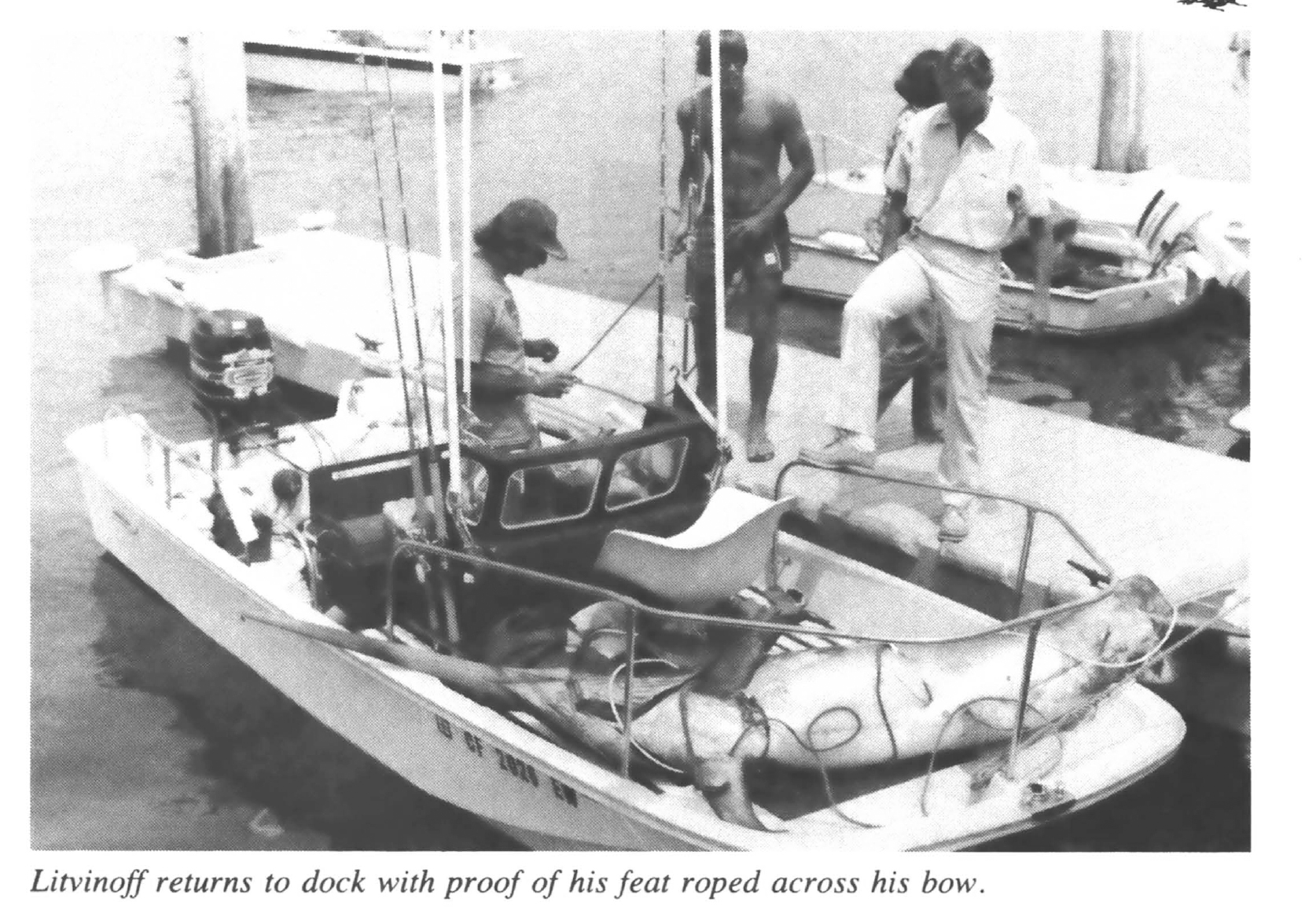I Fought an 11-Foot Swordfish Solo from My 17-Foot Boat
I first saw the swordfish at 7:50 a.m. about 12 miles off the coast. He was 50 yards away, swimming kind of erratically and slowly. He was so big that I was a little afraid of him at first. I figured he was well over 10 feet long.
When I spotted him I was on my way to a point 20 miles off Dana Point, California, where I’d seen a swordfish the previous weekend
It was July 26, 1980, and my goal was to catch a swordfish while fishing alone in my 17-foot Boston Whaler. This was my sixth serious attempt to find and catch a swordfish alone. I’m a physical therapist, and a weekend fisherman. I own a small boat because I can’t afford a big one
I used to catch bonito as a kid in a skiff at Redondo Beach, California, and pretend I was Ernest Hemingway fighting a marlin. I dreamed then of doing something great in ocean fishing.
All the experienced sportfishing skippers in Newport Beach who’d talked to me about swordfish told me they’d never heard of anyone catching a swordfish alone while fishing from a little boat. I don’t think any of them thought I could do it either.
But here I was by myself and staring at one right in front of me.
I put my outboard motor into neutral and prepared to offer a bait to the fish. I told myself to relax, and to do things methodically and correctly, but I could feel myself getting excited. I grabbed the squid I’d bought the night before, and I got a bit angry when I felt it and found it was still half frozen. I held it in the water and kneaded it to break up the ice and make it more supple.
I’d sewn a hook into the squid the night before, so I attached the squid to the leader and then put on my fighting belt. I put the squid over the side and paid out about 60 feet of line.
I put· the motor in gear and moved the boat slowly so as to get the squid behind me, watching the fish all the time. The sight of his black dorsal fin and tail on that gray morning was kind of scary. He was still swimming erratically, slowly. I remember thinking at the time that he resembled a person looking for a lost contact lens.
I held the rod in my left hand and steered the boat with my right. I made a slight left turn to put the bait about 10 feet from the fish, and I gave the bait a short, jigging action.
The swordfish turned slowly to the left, away from the squid. So I went around him again and presented the bait once more. This time, from 20 feet away, he turned on it. When he saw it, his fins stiffened. Then he picked up speed and went under.
I jigged the squid twice. The swordfish whacked the squid with his bill. Even with the reel in free spool, I could feel his incredible power traveling all the way up the line to me. Then, two more whacks five seconds apart. Line started going out. I could tell that the squid was in his mouth.
He wasn’t swimming fast, just steady. I reached into my duffel bag for my fighting harness, put it on, and clipped it to the reel.
The fish was swimming steadily away. About 45 seconds later I figured it was now or never. I kneeled because I was afraid he might pull me over the side when I set the hook, and I wanted a chance to hit the railing first. At that point I felt a little fear. I’d never caught a swordfish before, and I didn’t know what it would be like when I set the hook.
I put my 9/0 reel into gear and struck the fish three times, as hard as I could. The hookup felt solid. What do I do now, I wondered. I thought of stories I’d heard about long battles with swordfish-39 hours, 22 hours, 13 hours. And those were fought by guys on big boats who had help.
I didn’t have a deckhand to keep my fighting chair facing the fish, another holding the gaff, or a skipper to run the boat. But I had good gear and I was mentally prepared. Still, I was apprehensive.
In the summer of 1978 I’d caught a 192- pound striped marlin while fishing by myself six miles off the east side of Catalina. But anyone who’s caught a swordfish will tell you that if you multiply a hard fight with a big marlin by 10, you’ll have a rough idea of how tough a swordfish is.
Catching a swordfish under any circumstances is tough. I know guys who’ve been fishing for swordfish for years and never had a strike. Even if you find one finning, the chances of it going after your squid are well below 10 percent
I figured the swordfish would run like a train when I struck, but he just kept swimming steadily. He never broke pace.
I had 620 yards of 80-pound-test Dacron line behind 15 feet of monofilament leader and 15 feet of double Dacron line. I tried reeling in. It was easy. Why is this so easy, I wondered. Then it hit me: The swordfish doesn’t know he’s hooked! I remembered stories of swordfish that had been hooked for four hours and then suddenly began feeding on mackerel.
He went down and swam around the boat once. Then he came up and jerked his head from side to side three times. He was gorgeous! He seemed to be lit up, a purple-blue fluorescence.
Now he knows he’s hooked, I thought. And man, did he take off! He took out 300 yards of line, and it was screaming. The heat on the reel was unreal. He was going so hard the harness was making it hard for me to breathe.
That was 30 minutes after I’d hooked him. With one hand I turned on my radio transmitter and said, ”This is the boat ‘Lundy Tours.’ Are any boats in the area” No answer. Then I worried that there was no one within 20 miles. I called every 10 minutes for a while. Finally I got a response from a boat called “Lovely Doll.”
“What can I do for you?” a man asked.
I said, “My name’s Larry. I’m on a seventeen-foot boat by myself, and I’m hooked up with a swordfish.”
“Are you sure it’s a swordfish?” the guy asked.
“That’s an affirmative,” I said
“Are you sure it’s not a shark?”
“That’s an affirmative.”
“OK, we’ll come find you. I’ve got a big boat and a fighting chair. You can get in my boat.”
“No, I don’t want to change boats. I want to do it in my boat. I just want to keep in touch with someone, that’s all.”
Pretty soon, the news was all over the ocean. Many people were talking about it on the radio. I relaxed for the first time and thought, Hey, it’s me, out here alone with a big fish, a big ocean, and my little boat. Am I dreaming this? What a great feeling! All those people on the radio were pulling for me.
The next 2ó hours were a tug-of-war. The reel’s star drag got so hot I couldn’t touch it. A couple of times the fish headed toward the boat, and I had to reel in fast. Or he’d be north of me and suddenly head south and turn the boat around 180°. That happened five times. I’d shut the motor off, but during the long fight I turned it on twice and let it run so as to charge the battery.
He looked like a huge black shadow under the water. He was spent, but I was cautious because I’d heard stories of swordfish going crazy at the gaff, attacking boats or filleting themselves on a gaff.
I changed my position, alternating between my fighting chair in the bow and the bench at the steering wheel. I found that when I was in the chair the boat would move in the direction the swordfish was going. I wanted him pulling the boat sideways s~ that he’d tire.
It was difficult to maneuver between the chair and the bench. When I did it I’d put the reel in neutral. I felt that if I left the reel in gear there was a chance the fish might yank me over the boat’s railing and into the sea.
After the 2 1/2 hours had gone by the fish cut loose with a couple of really hard surges. At that point, I was feeling great fatigue in my hands, forearms, shoulders, and back.
Now came my worst moments. The fish was smoking, and I needed to get into the fighting chair. I jammed the rod butt into the chair’s gimbal (a metal cup the rod butt fits into), and the gimbal fell off. The screw holding it to the chair had come out and had fallen through the decking. I pulled up the hatch cover and could see the screw but couldn’t reach it. By rocking the boat, I made the screw roll to where I could grab it.
I decided there was no way I could catch that swordfish without repairing the chair. For all I knew then I’d be fighting the fish for 18 hours. So I got a screwdriver from the dashboard and fixed the gimbal with one hand.
My confidence was pretty high, so when I got into the chair I decided to get aggressive. It was close to 11 a.m. I knew that in another hour the wind would start kicking up the sea. I got competitive and went oneon- one with that fish.
The fish had about 300 yards of line out when I started pumping. For half an hour I slowly gained line. The fish got close, and the double line came out of the water. I was excited though I half expected the fish to rip off 400 or 500 yards of line any minute.
Now I was at a critical point. I must gaff the fish. When I had the double line around the spool four times, I gave one last heave on the rod and reached out and grabbed the leader. I saw the fish for the first time since hours earlier, when he’d shaken his bill near the boat.
He looked like a huge black shadow under the water. He was hooked outside his jaw, which is typical of a swordfish hookup. The leader ran down his left side and was wrapped once around his tail. He wasn’t dead, but he was spent. At least he looked spent. But I was cautious because I’d heard stories of swordfish going crazy at the gaff, attacking boats or filleting themselves on a gaff.
But he never even flinched when I hit him in the shoulder with a flying gaff. I got a second gaff in his tail, pulled him in close, and got a line around his tail. Then I grabbed him by the bill and whacked his head three times with an ax handle. Then I ran a line through his gill and tied him to the boat.
It was all over. The fight had lasted three hours and 55 minutes. I sat for five minutes and looked at him, wondering if I’d done something no one had ever done. I tried to pull him into the boat but couldn’t even lift his head out of the water.
I got on the radio to the “Lovely Doll” again.
“‘Lovely Doll’ this is ‘Lundy Tours,’” I said. ”I want you to know I just gaffed a swordfish by myself.”
Then I poured myself a rum and Coke and started worrying about sharks.

I headed for Newport Beach to weigh the fish at the Balboa Angling Club. The boat was listing because the fish’s weight was pulling down one side. I ran into a sportfisher called ”Bess Bet.” The three guys on board helped me untie the fish and lift him onto my bow, where we tied him again.
At that point, when I knew the fish was out of shark danger, fatigue hit me hard. My legs went rubbery. I must have talked 20 minutes nonstop to those guys. I borrowed their swordfish flag and ran it up one of my outriggers.
Read Next: The Best Saltwater Rods, Tested and Reviewed
I can’t describe the feeling I had, coming into Newport harbor with that fish draped over my bow. It was the first swordfish of the season. People stood on docks and beaches and cheered me. Boat horns blew. I stopped first at Bisbee’ s tackle shop dock and the people there gave me a bottle of champagne. There were a lot of people waiting for me at the Balboa Angling Club too. They cheered when I was photographed with the swordfish. He measured 11 feet 6 inches and weighed 336 pounds.
This story, “A Swordfish the Hard Way,” first appeared in the October 1981 issue of Outdoor Life.
The post I Fought an 11-Foot Swordfish Solo from My 17-Foot Boat appeared first on Outdoor Life.
Source: https://www.outdoorlife.com/fishing/solo-fisherman-lands-giant-swordfish/






